Why Understanding Small Foundation Cracks is Critical for Every Homeowner
Small foundation cracks are a common but misunderstood concern for homeowners. While many are harmless, others can signal serious structural issues that worsen over time.
Types of Small Foundation Cracks:
- Vertical/Hairline – Usually harmless shrinkage from concrete curing.
- Diagonal – May indicate settling; monitor for growth.
- Horizontal – The most serious type, indicating structural pressure.
- Stair-step – Common in block foundations; can signal settlement.
When to Worry:
- Crack is wider than 1/8 inch.
- Water is seeping through the crack.
- The crack is growing.
- You also have sticking doors or windows.
Knowing which cracks to monitor and which demand immediate attention is key. A thin vertical crack could be a minor DIY fix or a sign of costly structural damage. That uncertainty is stressful.
I’m Darin Garvey, and with over 30 years of experience in basement waterproofing and foundation repair in the Philadelphia area, I’ve helped homeowners address small foundation cracks before they become major problems. Early detection and proper assessment can save you thousands and protect your most valuable investment.
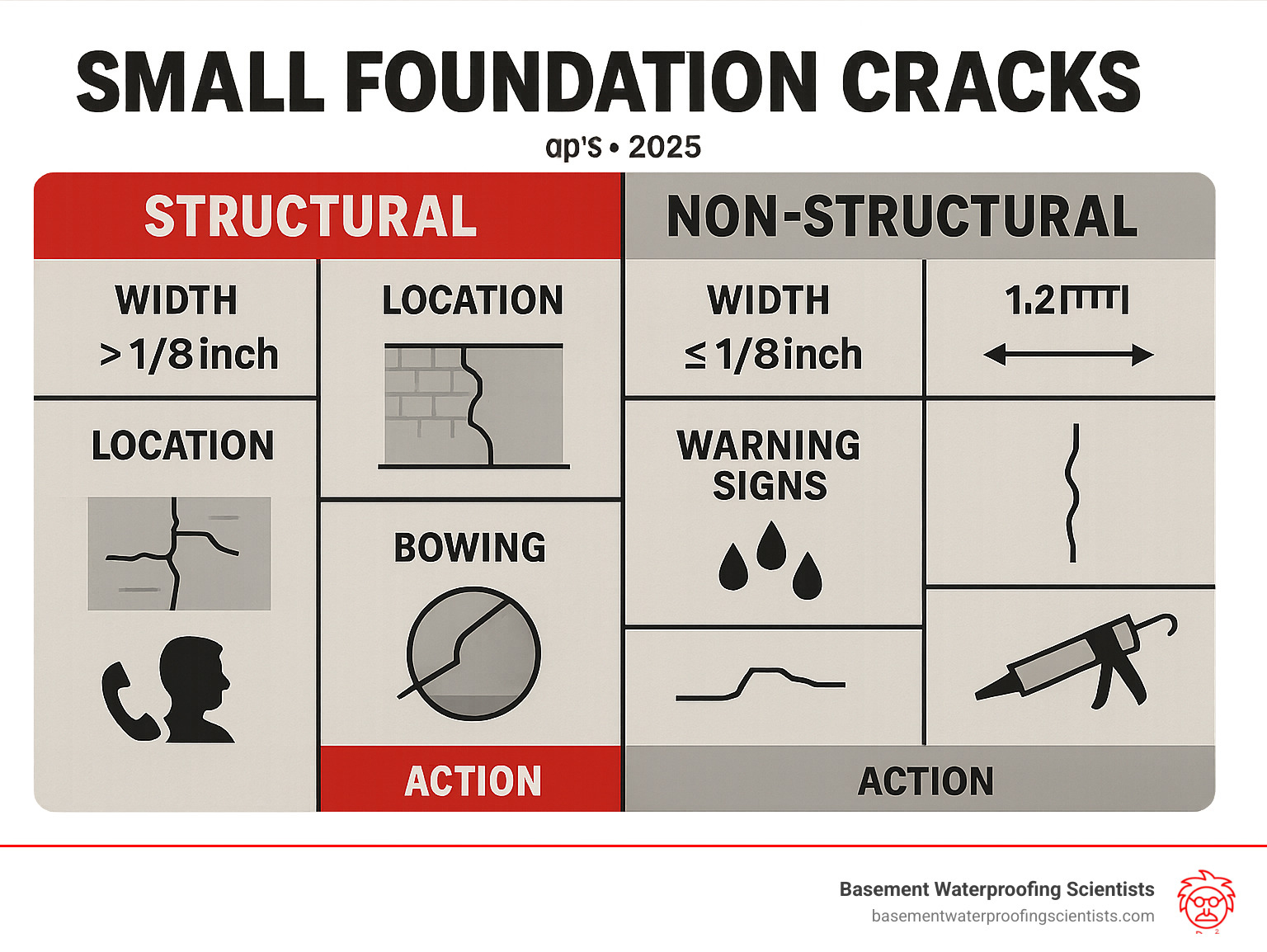
Small foundation cracks vocab explained:
Decoding the Cracks: Common Types and What They Mean
Think of foundation cracks as your home’s way of communicating. Some are harmless, while others are cries for help. To understand them, look at their direction, width, and location. A hairline vertical crack is usually just concrete settling, but a growing horizontal crack is a different story.
The difference between structural and non-structural cracks is the cause. Non-structural cracks come from normal concrete drying and shrinking. Structural cracks mean external forces are stressing your foundation in ways it wasn’t designed to handle.
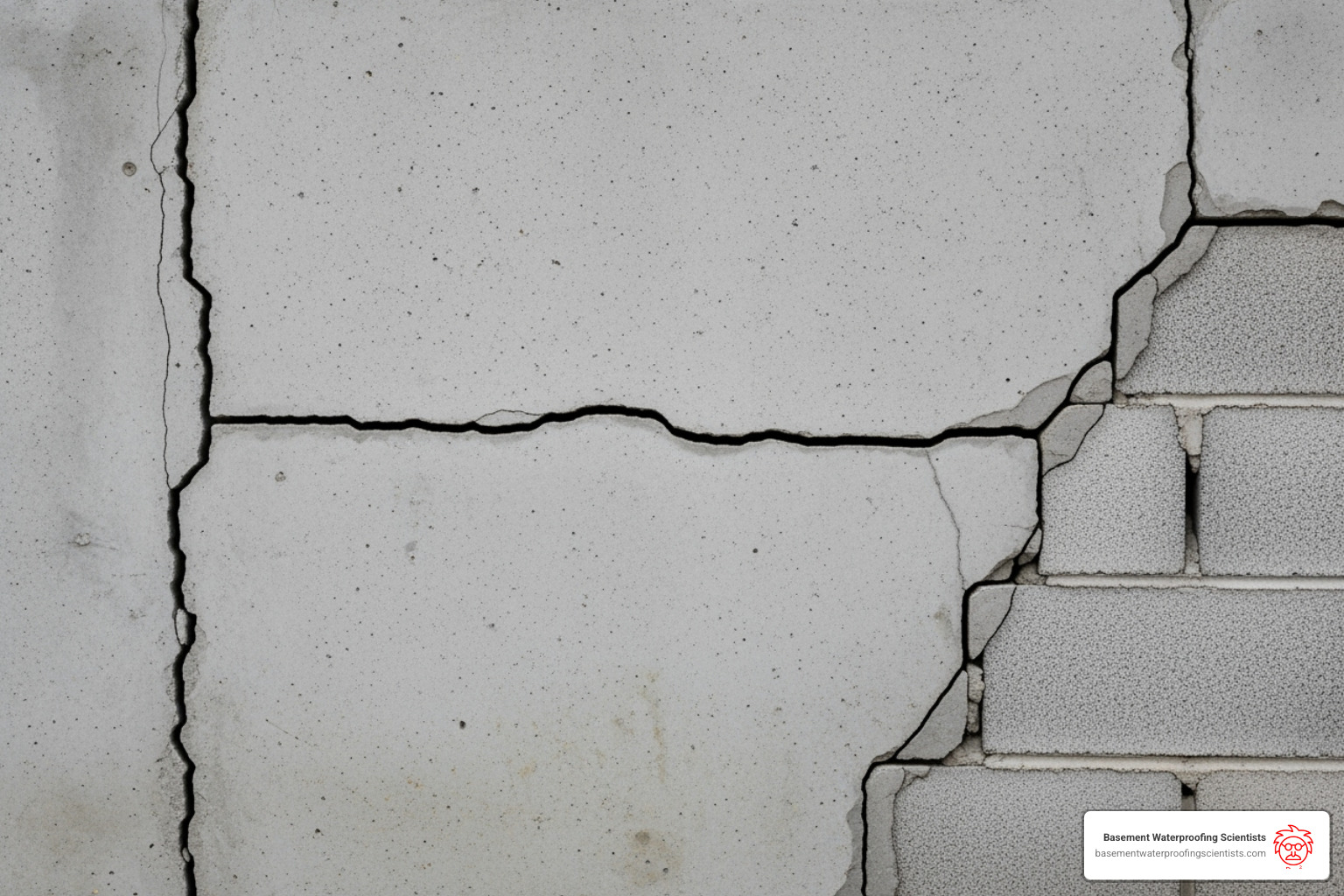
Vertical & Hairline Cracks
Vertical and hairline cracks are the most common type, especially in newer homes. As freshly poured concrete cures, it loses moisture and shrinks, creating fine vertical lines usually less than 1/8 inch wide. This is called concrete curing shrinkage.
Most vertical cracks are just your home settling and are not structural threats. However, even harmless cracks can let water into your basement, leading to dampness or mold. If a vertical crack widens or starts to leak, it’s time to take action.
Diagonal Cracks
Diagonal cracks run at an angle, usually around 30 degrees from vertical. They often indicate differential settlement, where one part of your home settles differently than another. This can happen if the soil under one section is softer or wetter than elsewhere.
Many diagonal cracks are harmless, but they deserve monitoring, especially if they are wider at one end or growing. They can be a sign that your foundation is under uneven stress. If you see changes, it might be time to explore foundation repair services to address the root cause.
Horizontal Cracks
Horizontal cracks are the most serious. They run sideways across your foundation wall and are a major distress signal. They typically form when external forces, like hydrostatic (water) pressure or expanding clay soil, push against your foundation walls.
This pressure can cause walls to bow inward, creating horizontal stress cracks. Even a small horizontal crack indicates significant forces are at work. If you spot one, treat it seriously and seek immediate professional attention. They rarely get better on their own and can lead to structural failure.
Stair-Step Cracks
Stair-step cracks are found in block or brick foundations, zigzagging along the mortar joints. They are a clear sign of foundation settlement. When one section of the foundation sinks or rises, the stress follows the weakest path—the mortar joints.
What starts as small foundation cracks in a stair-step pattern can indicate significant problems with the underlying soil, such as erosion or poor compaction. They are especially concerning if they are growing or if you see other signs like bowing walls or sticking doors. These cracks mean settlement is actively occurring and needs professional repair. For more details, see our guide on understanding structural basement repair: what you need to know.
The Root Causes: Why Do Foundation Cracks Appear?
Understanding why small foundation cracks appear is as important as identifying them. Most cracks are a response to specific forces, and water is usually the main culprit.
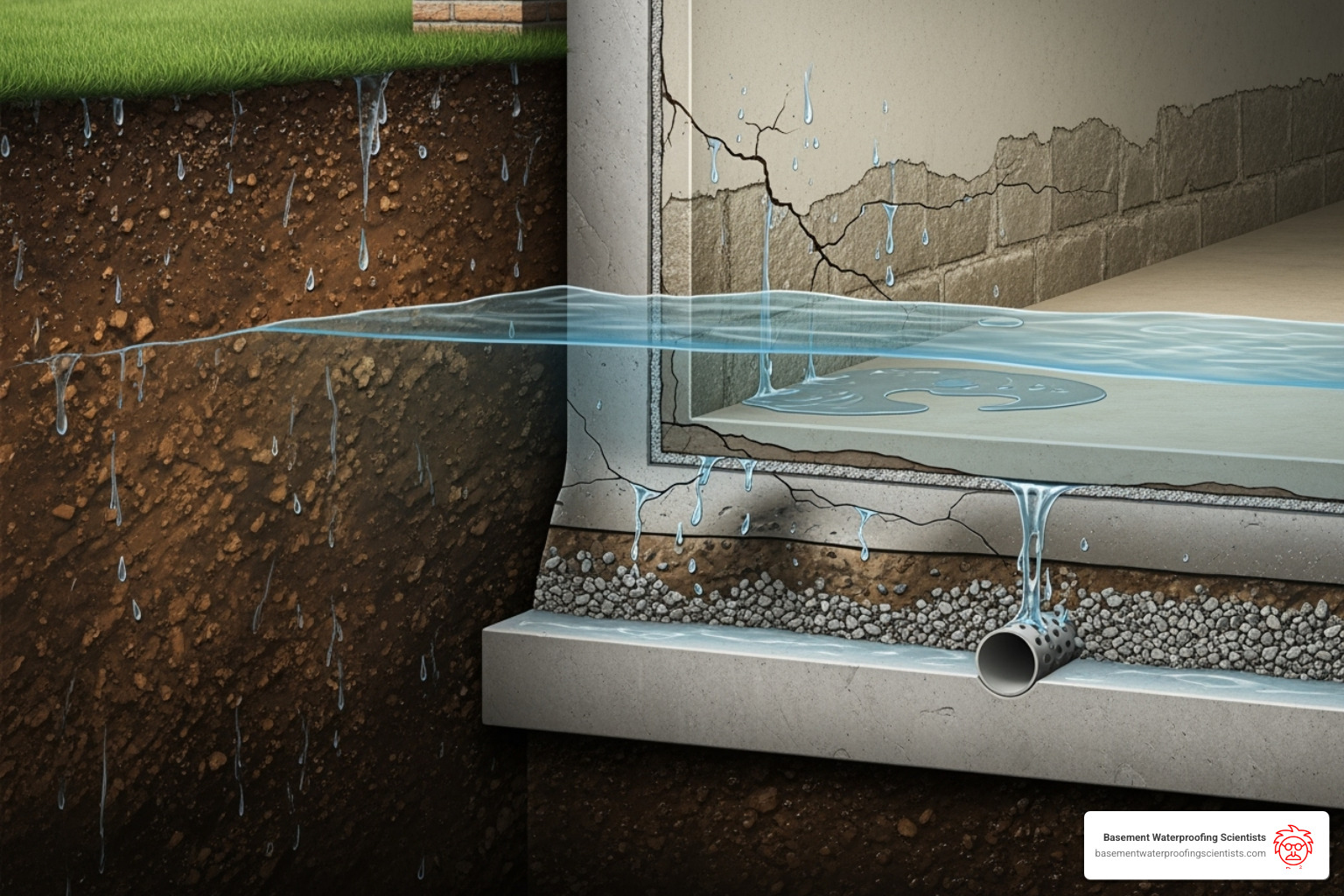
Natural Concrete Curing and Shrinkage
Some of the most common small foundation cracks are a normal part of how concrete behaves. As new concrete dries, it shrinks. This concrete drying process can continue for up to a year, which is why you might see new hairline cracks in a newer home.
These shrinkage cracks are typically very thin (less than 1/16 inch) and vertical. While not a structural concern, they can create a pathway for moisture. You can learn about concrete shrinkage to understand the technical details.
Environmental Pressures: Soil and Water
The soil around your home is constantly shifting due to moisture and temperature changes.
- Hydrostatic pressure: Water buildup in the soil from rain or poor drainage creates immense pressure against basement walls.
- Expansive clay soils: These soils swell dramatically when wet and shrink when dry, creating powerful forces against your foundation. In fact, expansive soils cause more property damage in the U.S. than earthquakes, floods, and tornadoes combined.
- Frost heave: In colder climates, frozen soil expands and can push your foundation upward, causing cracks when it thaws and settles.
- Poor drainage: Clogged gutters and improper yard grading direct water toward your foundation, worsening soil saturation.
- Tree roots: Large roots can absorb moisture, causing soil to shrink and settle, or they can physically push against the foundation.
Foundation Settlement
All homes settle, but the key is whether the settlement is uniform (the whole house settles evenly) or differential (one part settles more than another).
Differential settlement is the problem. It puts tremendous stress on foundation walls, causing diagonal or stair-step cracks. This can be caused by:
- Poor soil compaction: If the soil wasn’t properly compacted during construction, it can compress over time under your home’s weight.
- Soil erosion: Water can wash away soil that supports your foundation, creating voids that cause parts of the foundation to drop.
Managing water around your foundation is crucial for both keeping your basement dry and protecting the soil that supports your home. For comprehensive solutions, explore our foundation repair and waterproofing services.
Assessing the Damage: When to Worry About Small Foundation Cracks
Not every foundation crack signals disaster. The key is to play detective and separate minor cosmetic issues from serious problems.
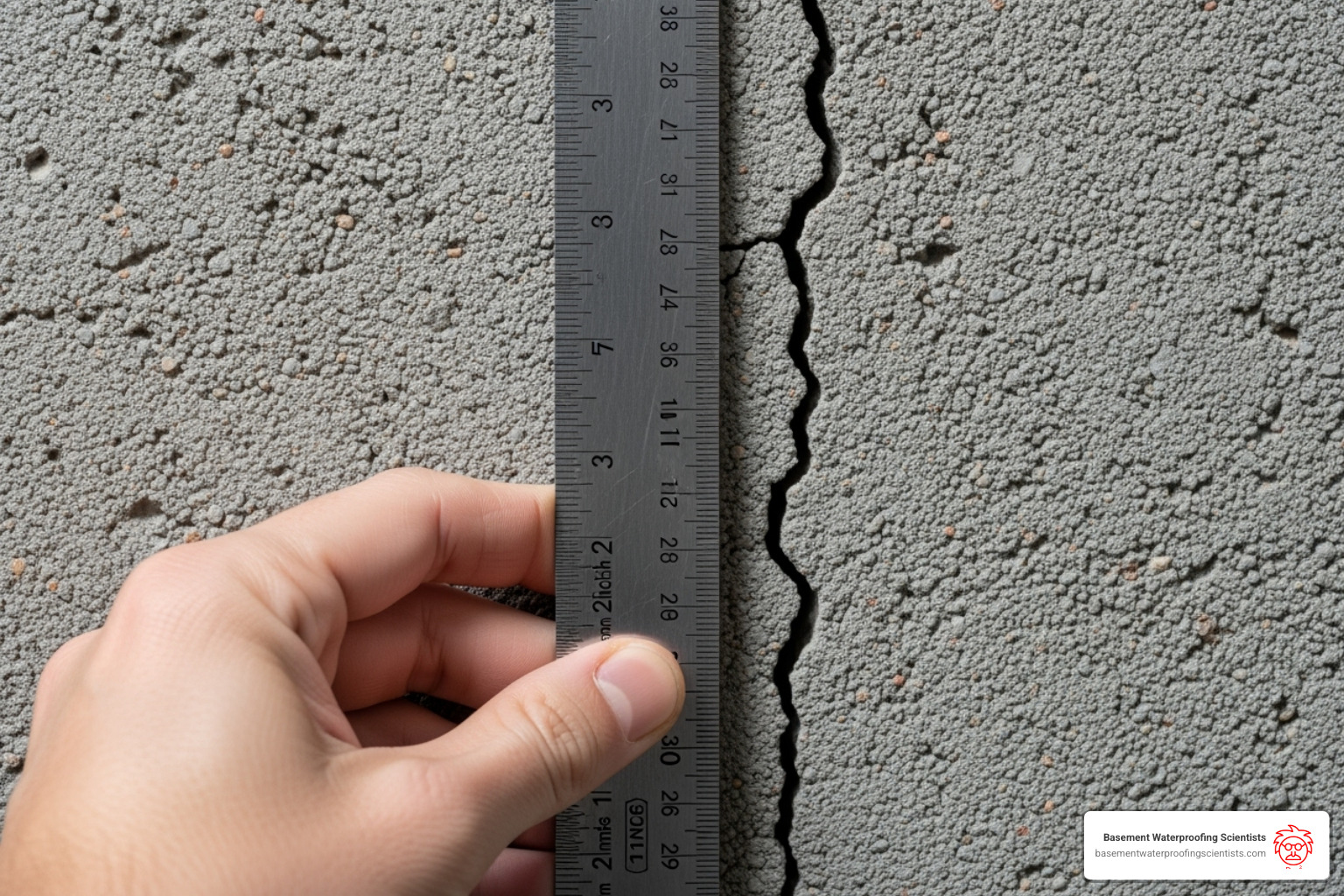
How to Evaluate a Foundation Crack
When you spot a crack, gather some evidence before panicking. Check these factors:
- Crack width: Use the “dime test.” If a dime fits in the crack, it’s likely wider than 1/8 inch and needs attention. The National Association of Home Builders suggests that cracks over 1/4 inch wide require repair.
- Is it growing? This is crucial. Mark the ends of the crack with a pencil and date it. Check back in a few months. If it has grown, you’re dealing with ongoing movement that needs a professional.
- Water seepage: Look for dampness or water trickling through. Even a tiny crack can become a moisture highway, leading to mold and other damage.
- Location: Cracks near windows and doors often indicate settling. Horizontal cracks are always serious. Stair-step patterns in block foundations signal settlement.
Warning Signs Beyond the Crack Itself
Sometimes small foundation cracks are just one symptom. Look for these other warning signs:
- Doors and windows that stick or won’t close properly.
- Sloping, bouncy, or uneven floors.
- Gaps appearing between walls and ceilings.
- Damp spots, puddles, or musty odors in the basement.
- Walls that bow or bulge inward.
The Consequences of Ignoring the Problem
Ignoring foundation cracks rarely ends well; the problem almost always gets more expensive to fix.
- Escalating structural damage: A hairline crack can grow, eventually compromising your home’s structural integrity.
- Increased repair costs: A simple crack injection today might cost a few hundred dollars. Waiting until it requires major structural work like underpinning could cost $5,000 to $15,000 or more.
- Water damage and mold: Water intrusion damages belongings, creates electrical hazards, and provides a breeding ground for mold and mildew, which can affect your family’s health.
- Pest infestations: Insects and rodents can enter through cracks.
- Decreased home value: Foundation issues are a major red flag for potential buyers.
The bottom line is that small foundation cracks deserve respect and prompt attention. When in doubt, find reliable foundation repair services to get a professional opinion.
Your Action Plan: Repairing Foundation Cracks
Once you’ve assessed your small foundation cracks, it’s time for action. Knowing when to DIY versus when to call an expert can save you money and future headaches.
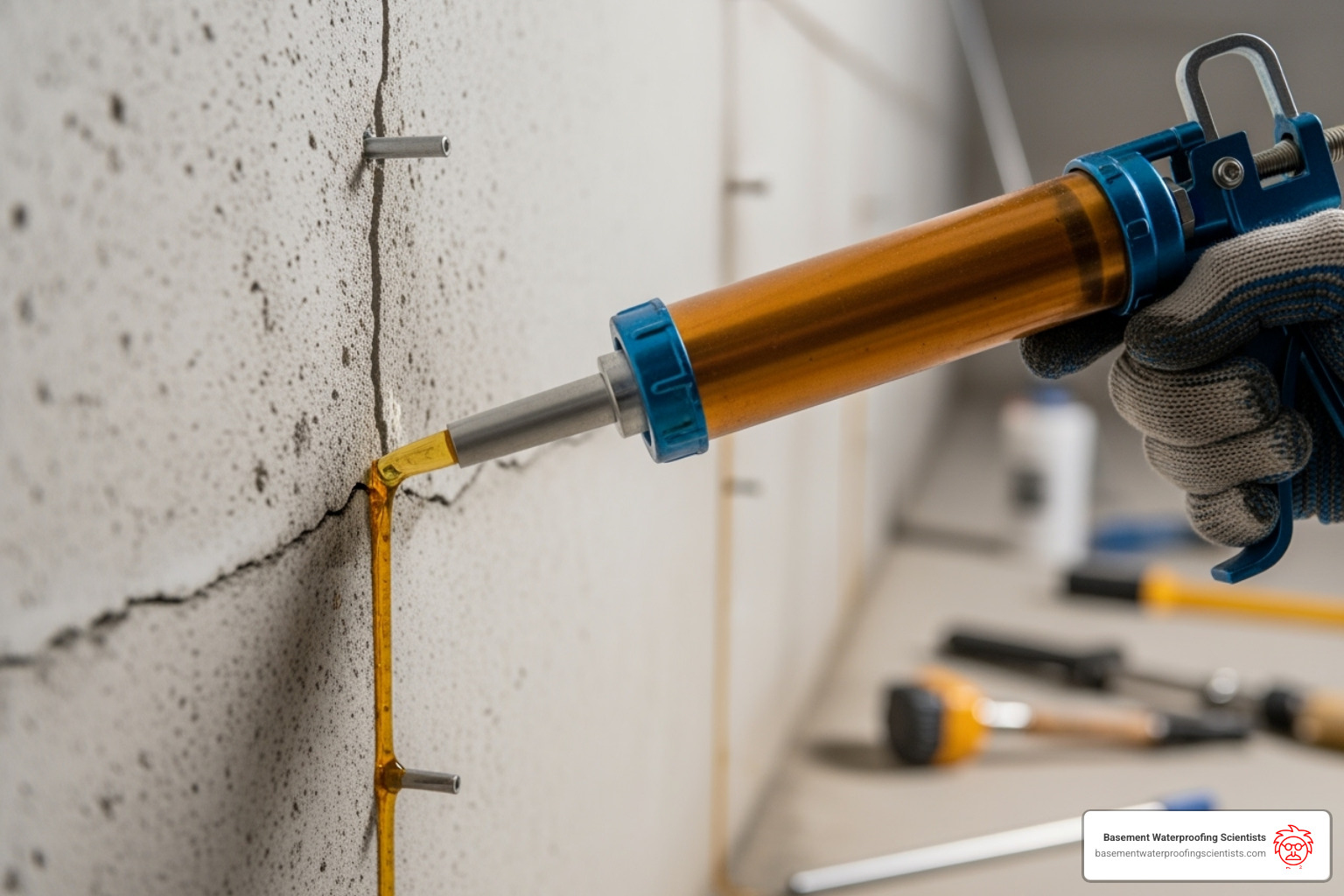
DIY vs. Professional Repair: Making the Right Choice
When DIY makes sense: A hairline crack (less than 1/8 inch wide) that isn’t growing or leaking is a potential DIY candidate. You can find epoxy or polyurethane sealant kits at home improvement stores for under $100.
The risks of going it alone are significant. A simple caulk job might seem to work, but if you don’t address the underlying cause, the crack can return, leading to a bigger, more expensive problem later.
When to call a professional:
- Any crack wider than 1/8 inch.
- All horizontal cracks, regardless of size.
- Any crack that is actively growing or leaking water.
- Cracks accompanied by other warning signs like sticking doors or bowing walls.
Professionals have the right equipment and expertise to fix the problem correctly the first time. As we know, foundation repair mistakes can seriously damage your home, and prevention is always cheaper than correction.
Common Professional Repair Methods
Professionals use sophisticated solutions to address not just the crack, but its cause.
- Epoxy Injection: Used for vertical/diagonal cracks in poured concrete. The epoxy bonds the concrete, restoring the wall’s original strength and creating a watertight seal.
- Polyurethane Foam Injection: This flexible foam expands to fill every void, making it ideal for active leaks or cracks that may experience minor future movement.
- Carbon Fiber Straps: These high-strength straps are applied to bowing walls to prevent further inward movement and stabilize the structure.
- Steel Piers (Underpinning): When settlement is the cause, steel piers are driven to stable soil or bedrock to lift and permanently stabilize the foundation.
- Exterior Waterproofing: This involves excavating to apply a waterproof membrane and install drainage systems, offering the most comprehensive protection against water intrusion.
Each method is chosen to provide a lasting repair. You can learn more about these top-rated foundation repair techniques for homeowners in 2024.
Frequently Asked Questions about Foundation Cracks
Over my 30+ years helping homeowners in Philadelphia and surrounding areas, I’ve heard every question imaginable about foundation cracks. Here are the most common ones.
Are all small foundation cracks a sign of a serious problem?
No, not all of them. Many small foundation cracks, especially hairline vertical cracks in newer homes, are a normal result of concrete curing and minor settling. They are typically cosmetic.
However, you should always monitor any crack. If it grows, changes direction, or starts leaking water, it’s time to call a professional for an assessment.
How much does it cost to repair a small foundation crack?
Costs vary widely. A simple DIY kit for a hairline crack might be under $100. Professional injection for a single non-structural crack typically costs between $400 and $800.
If the crack is a symptom of a larger structural issue requiring methods like underpinning or carbon fiber straps, costs can range from $5,000 to $15,000 or more. Comprehensive basement waterproofing solutions average between $4,000 and $8,000. Catching problems early is the best way to keep costs down.
Does homeowners insurance cover foundation crack repair?
Unfortunately, most standard homeowners insurance policies do not cover foundation repair. Insurance typically excludes damage from natural settling, shifting soil, or general wear and tear, viewing these as maintenance issues.
An exception might be if the cracks were caused by a specific, covered event like a burst pipe or a natural disaster (if you have that specific coverage). Always check your policy or call your agent to understand your specific coverage.
Protect Your Home’s Foundation for the Long Term
Noticing small foundation cracks is the first step to protecting your home. Now you have the knowledge to act.
- Monitor Proactively: Check your basement walls every few months, especially after heavy rain. A simple photo log can help you track changes.
- Intervene Early: Sealing a small crack now might cost a few hundred dollars. Waiting until it becomes a major structural problem could cost $10,000 or more.
- Protect Your Investment: A sound foundation protects your home’s value. Proper maintenance and professional repairs are reassuring to potential buyers.
- Gain Peace of Mind: Knowing your foundation is secure eliminates the stress of wondering if a small problem is getting worse.
At Basement Waterproofing Scientists, we’ve spent 30 years helping homeowners in Philadelphia, Reading, Norristown, and throughout Pennsylvania, New Jersey, and Delaware. Our specialized equipment helps us pinpoint leak sources, allowing us to fix them efficiently and for less money.
We believe in straight talk and solutions that last, which is why we back our work with a lifetime guarantee. Don’t let small foundation cracks grow into big problems. If you see cracks that are growing, leaking, or wider than a dime, it’s time to call an expert.
Schedule your professional basement wall crack repair today. Let us help you ensure your home stands on a foundation you can count on.

